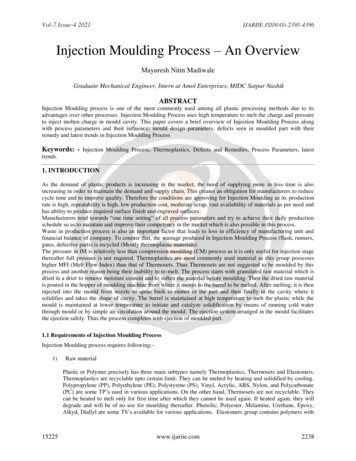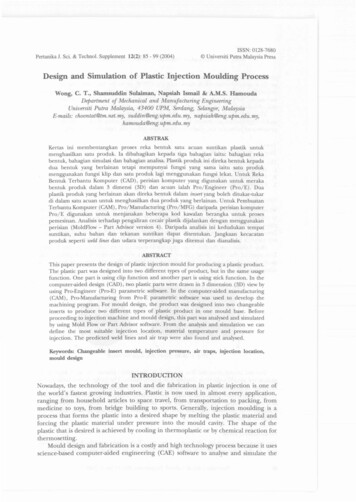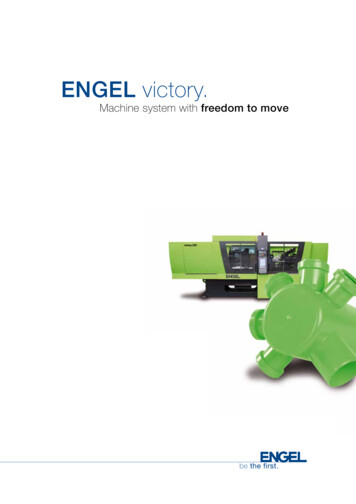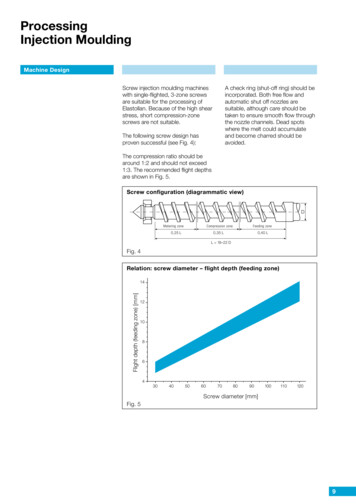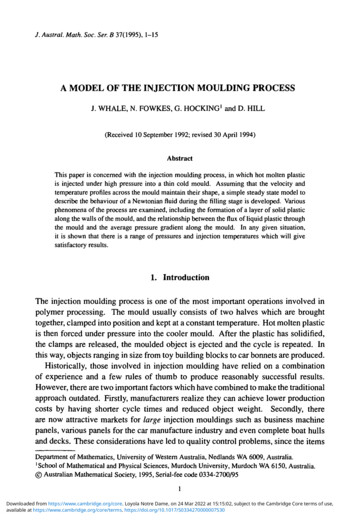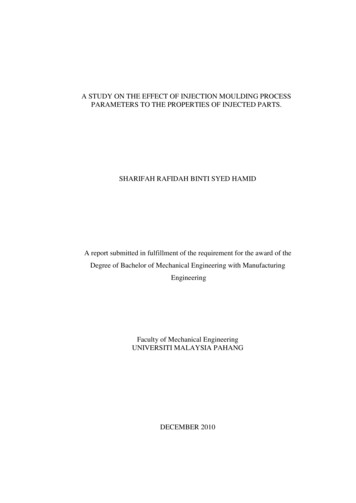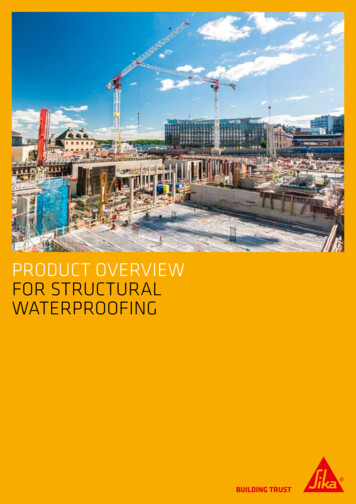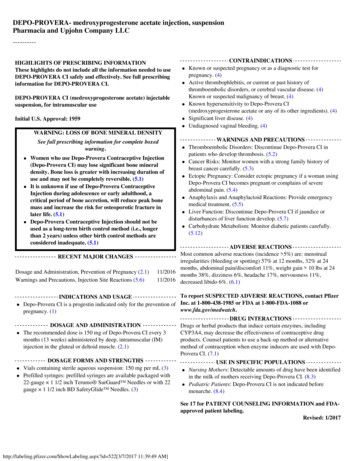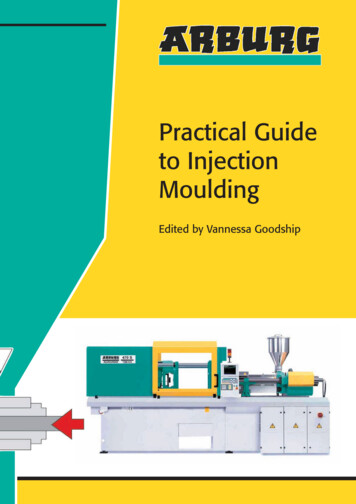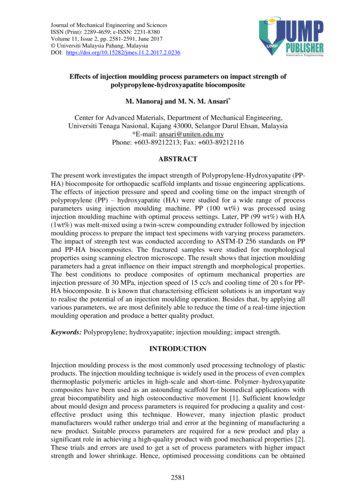
Transcription
Journal of Mechanical Engineering and SciencesISSN (Print): 2289-4659; e-ISSN: 2231-8380Volume 11, Issue 2, pp. 2581-2591, June 2017 Universiti Malaysia Pahang, MalaysiaDOI: cts of injection moulding process parameters on impact strength ofpolypropylene-hydroxyapatite biocompositeM. Manoraj and M. N. M. Ansari*Center for Advanced Materials, Department of Mechanical Engineering,Universiti Tenaga Nasional, Kajang 43000, Selangor Darul Ehsan, Malaysia*E-mail: ansari@uniten.edu.myPhone: 603-89212213; Fax: 603-89212116ABSTRACTThe present work investigates the impact strength of Polypropylene-Hydroxyapatite (PPHA) biocomposite for orthopaedic scaffold implants and tissue engineering applications.The effects of injection pressure and speed and cooling time on the impact strength ofpolypropylene (PP) – hydroxyapatite (HA) were studied for a wide range of processparameters using injection moulding machine. PP (100 wt%) was processed usinginjection moulding machine with optimal process settings. Later, PP (99 wt%) with HA(1wt%) was melt-mixed using a twin-screw compounding extruder followed by injectionmoulding process to prepare the impact test specimens with varying process parameters.The impact of strength test was conducted according to ASTM-D 256 standards on PPand PP-HA biocomposites. The fractured samples were studied for morphologicalproperties using scanning electron microscope. The result shows that injection mouldingparameters had a great influence on their impact strength and morphological properties.The best conditions to produce composites of optimum mechanical properties areinjection pressure of 30 MPa, injection speed of 15 cc/s and cooling time of 20 s for PPHA biocomposite. It is known that characterising efficient solutions is an important wayto realise the potential of an injection moulding operation. Besides that, by applying allvarious parameters, we are most definitely able to reduce the time of a real-time injectionmoulding operation and produce a better quality product.Keywords: Polypropylene; hydroxyapatite; injection moulding; impact strength.INTRODUCTIONInjection moulding process is the most commonly used processing technology of plasticproducts. The injection moulding technique is widely used in the process of even complexthermoplastic polymeric articles in high-scale and short-time. Polymer–hydroxyapatitecomposites have been used as an astounding scaffold for biomedical applications withgreat biocompatibility and high osteoconductive movement [1]. Sufficient knowledgeabout mould design and process parameters is required for producing a quality and costeffective product using this technique. However, many injection plastic productmanufacturers would rather undergo trial and error at the beginning of manufacturing anew product. Suitable process parameters are required for a new product and play asignificant role in achieving a high-quality product with good mechanical properties [2].These trials and errors are used to get a set of process parameters with higher impactstrength and lower shrinkage. Hence, optimised processing conditions can be obtained2581
Effects of injection moulding process parameters on impact strength of polypropylene-hydroxyapatitebiocompositefrom experimental results using the obtained set of parameters. The first idea of HAreinforced polyethylene composite to be utilised as a bone substitute was conceived anddeveloped by Bonfield [3]. Since then, the mechanical properties of hydroxyapatite (HA)reinforced polyethylene composite have been studied extensively [3]. The blend ofbioactive but brittle hydroxyapatite and ductile high-density polyethylene gives decentbiocompatibility and sufficient mechanical properties of the composite specimens [4].Based on hydroxyapatite (HA) reinforced high-density polyethylene (HDPE), anincredible number of polymer matrix bio composites have been proposed. However, thesub-par mechanical properties of these composites restricted their applications as nonloadbearing inserts [5, 6]. Impact strength is an important factor in defining the quality ofinjection moulded products. This factor is influenced by the processing parametersgoverning injection moulding processes as have been shown in many studies. Cambell etal. studied the effect of injection moulding process parameters on the tensile and impactstrength of polypropylene and concluded that the processing parameter interactionssignificantly impacting the part’s mechanical properties [7, 8].Inappropriate settings for processing parameters (such as mould temperature,nozzle and barrel temperatures, injection speed and pressure, holding pressure and time,and cooling time) can result in products with weaker impact strength or poor quality [9].Therefore, determining the appropriate combinations for the processing parameters isimperative for optimising injection moulding operations. Wang et al. [10] examined twomethodologies to enhance the interfacial condition in polyethylene–hydroxyapatitecomposites in altering their mechanical properties: the utilisation of silane treatedhydroxyapatite as filler, and the use of polymer uniting for polyethylene. Thepolypropylene/hydroxyapatite composite was produced using a technique which wasutilised for polyethylene–hydroxyapatite [10]. Cunha et al. [11] considered the impact ofprocessing conditions on the mechanical conduct of the HA/UHMWPE composite usinginjection and compression moulding, and found that the injection moulding procedureguaranteed preferable results over compression moulding because of the serious blendingand shearing of the polymer. Ward et al. [12] demonstrated part of pressure annealing inenhancing the firmness of polyethylene/hydroxyapatite composites. In the present work,polypropylene (PP)-hydroxyapatite (HA) composites were developed by twin-screwextruder using blended powder of HA and granules of PP. The combined composites weresubjected to heat and pressure in the injection moulding machine and the mechanicalproperties PP–HA composites were studied.Among the mechanical properties, impact strength was more affected byprocessing factors than other mechanical properties. The impact strength of the PP-HAcomposites is mainly influenced by many factors including matrix intrinsic properties,optimum HA–matrix interaction, HA concentration, HA geometry, HA–matrix stresstransfer efficiency, HA orientation, and HA dispersion and distribution [13, 14]. At thesame time, the HA bridging, HA pull-outs, crack propagation and matrix deformationmechanisms contribute a vital role in the impact rupture of HA reinforced composites [14,15]. Many of these mechanisms contribute simultaneously during impact tests whichmake it complicated to determine the impact strength of the composites. The process flowis described in Figure 1.2582
Manoraj and Ansari / Journal of Mechanical Engineering and Sciences 11(2) 20172581-2591Twin-screw Extrusion Process(Compounding)Injection Moulding Process(Sample preparation)Hydroxyapatite reinforcedPolypropylene (PP-HA)1. Data compilation2. Results and Analysis(ANOVA)Characterisation Methods1) Mechanical Test2) Morphological StudiesFigure 1. Block diagram of the experimental processes.METHODS AND MATERIALSA commercial polypropylene impact copolymer (TITANPRO SM 840) with melt flowindex (MFI) of 0.7 g/10 min at 2.16 kg and 230 C and Hydroxyapatite (HA) was suppliedby M/s.Pultrusion Sdn. Bhd., Malaysia. It has a purity of 99% and the average particlesize is 2-10 µm. The colour of Hydroxyapatite is white and spherical in shape.Polypropylene granules were melt-mixed and compounded with HA powder using a corotating twin-screw extruder (Nanjing Norda Xinye Extrusion Equipment Co., Ltd: TDS16) with a screw speed of 30 60 rpm at 200 C. The filler content (HA) was fixed at1wt% due to its nano-sized particle dimensions. These mixtures were measured based onthe formulation (wt.%) shown in Table 1.Table 1. The formulation of nanocomposite compounding.Formulation PP (wt%) HA (wt%)1 (PP)100%0%2 (PP-HA)99%1%(a)(b)Figure 2. (a) Twin-screw Extruder (Nanjing) (b) Injection Moulding Machine(HAITAN).After this process, the mixed materials which were in the form of granules weremoulded using an Injection Moulding Machine (Figure 2) at 185 C and pressures of 302583
Effects of injection moulding process parameters on impact strength of polypropylene-hydroxyapatitebiocompositeand 40 MPa with cooling times of 20 and 40 s and injection speeds of 15, 25, and 35 cc/s.Each sample was cut to 13 mm in width and 63 mm in length. Samples for the impact testwere prepared according to ASTM D-256 standards. Four specimens from each pressure,cooling time, and injection speed were tested and the average value was reported. Theprimary part of the work was concerned with the determination of the impact strength.Zwick/Roell HIT50P was used to perform the notched Izod tests as shown in Figure 3.ASTM D-256 standard was used to test rectangular notched bars for the verification ofpendulum impact-testing machines. The impact machine was utilised using the manualclamping vice with a sample adapter accurately positioned in the vice with a centeringdevice adapted for notched specimens and then hindered by turning a hand wheelclockwise. A screw available just in the middle of the hand wheel was used to control theclamping torque applied by means of a dynamometric key with a resolution of 0.5 N-mand a working torque range from 1 to 25 N-m. To dodge undesirable impacts, the researchcentre where the mechanical properties were measured was conditioned at 23.8 C and a50% relative moistness. The impact strength was figured by dividing the absorbed energyby the underlying cross-sectional area behind the notch. The normal values werecalculated from 10 runs for each sample.Figure 3. (a) The impact machine (Zwick); (b) Vice-clamp; (c) Impact test specimen.After this process, the granular compounded materials were moulded at 185 Cand pressures of 30 and 40 MPa with cooling times of 20 and 40 sec and injection speedsof 15, 25, and 35 cc/s. Each sample was 12.7 mm in width, 62.5 mm in length, and 3.2mm in thickness. Samples for impact test were prepared according to ASTM D-256standards. Table 2 shows the design of experiment which consists of five specimens fromeach pressure, cooling time, and injection speed that were tested and the average value isreported in the next section. The fracture surfaces of the impact test samples wereobserved using a Jeol S-360 scanning electron microscope (SEM). The configuration waspre-set to meet the optimised level of results.2584
Manoraj and Ansari / Journal of Mechanical Engineering and Sciences 11(2) 20172581-2591Table 2. Design of experiment.No. ofExperiment123456789101112Injection Pressure,P (MPa)303030303030404040404040Injection Speed,S (cc/s)152535152535152535152535Cooling Time,C (s)202020404040202020404040RESULTS AND DISCUSSIONThe PP-HA biocomposite samples were prepared using injection moulding method. Themechanical properties, especially the impact strength and fractured surface morphologicalproperties of the composites were tested. Figures 4 (a) – (d) show the impact strength ofPP and PP-HA biocomposites at various injection process parameters P30C20, P30C40,P40C20, and P40C40, respectively. In this chart, the injection speed was taken intoaccount and injection pressure and cooling time maintained at constant parameters. Thehighest impact strength for PP was obtained at the injection speed of 35cc/sec, injectionpressure of 30MPa, and cooling time of 20 secs (S35P30C20) was recorded as 237.3 J/m.The impact strength was reduced to 195.0 J/m after the incorporation of 1wt% HA. Thehighest impact strength for PP-HA biocomposite was obtained at the injection speed of15cc/sec, injection pressure of 30MPa, and cooling time of 20 sec (S15P30C20). Theimpact strength was recorded as 216.5 J/m. The impact strength of PP increased as theinjection speed increased for P30C20 and P40C20 experiments, whereas the impactstrength reduced after 25cc/sec for P40C20 experiment. Therefore, the optimum processparameter for PP was determined to be 25cc/sec for 40MPa/20sec experiment(S25P40C20). Scanning electron microscope (SEM) observation indicated that thebiomimetic HA crystals were uniformly distributed in the PP matrix. As the HA contentincreased in the composite, the fracture mechanism of the composites changed fromgliding fracture to gliding and brittle fracture.Figure 5 shows the impact strength of PP and PP-HA biocomposites at variousinjection pressures, and constant injection speed and cooling time designated asS15C20sec, S15C40, S25C20, S25C40, S35C20, and S35C40, respectively. The injectionpressure was taken into account with injection speed and cooling time maintained atconstant parameters. The highest impact strength for PP was obtained at the injectionspeed of 35cc/sec, injection pressure of 30MPa and cooling time of 20 sec (S35P30C20)was recorded as 228.3 J/m. The impact strength was reduced to 195.0 J/m afterincorporation of 1wt% HA. The highest impact strength for PP-HA biocomposite wasobtained at the injection speed of 15cc/sec, injection pressure of 30MPa, and cooling timeof 20 sec (S15P30C20) and recorded as 216.5 J/m.2585
Effects of injection moulding process parameters on impact strength of 10200190180170PP-HA at 30MPa, 20sPP at 30MPa, 40s237.3227.0224.0216.5206.0195.01525Impact strength (J/m)Impact strength (J/m)PP at 30MPa, tion speed (cc/s)PP at 40MPa, 20sImpact strength (J/m)(b)PP-HA at 40MPa, 20s240Impact strength ection speed (cc/s)220PP-HA at 30MPa, 40s196.5200.8195.0196.5190PP at 40MPa, 5180180PP-HA at 40MPa, 40s170170152515352535Injection speed (cc/s)Injection speed (cc/s)(c)(d)Figure 4. Effect of Injection Speed on Impact Strength of PP and PP-HA biocomposites(a) P30C20 (b) P30C40 (c) P40C20 (d) P40/C40.Figures 6 (a)–(f) show the impact strength of PP and PP-HA biocompositesprocessed at various cooling times, and constant injection speed and injection pressuredesignated as S15P30, S15P40, S25P30, S25P40, S35P30, and S35P40, respectively. Inthis chart, the cooling time was taken into consideration as the interaction parameter withinjection speed and pressure maintained at constant parameters. The highest impactstrength for PP was obtained at the injection speed of 35cc/sec, injection pressure of30MPa, and cooling time of 20 sec (S35P30C20) was recorded as 228.3 J/m. The impactstrength was reduced to 195.0 J/m after incorporation of 1wt% HA. The highest impactstrength for PP-HA biocomposite was obtained at the injection speed of 15cc/sec,injection pressure of 30MPa, and cooling time of 20 sec (S15P30C20). The impactstrength was recorded as 216.5 J/m.2586
Manoraj and Ansari / Journal of Mechanical Engineering and Sciences 11(2) 2017PP at 15cc/s, 20sPP-HA at 15cc/s, 20sPP at 25cc/s, 20sPP-HA at 25cc/s, 20s240Impact strength (J/m)Impact strength njection pressure (MPa)40Injection pressure (MPa)(a)PP-HA at 35cc/s, 20sPP at 15cc/s, 40s237.3230220210200200.8195.0195.019018030Impact strength (J/m)Impact strength (J/m)PP at 35cc/s, 20s240(b)PP-HA at 15cc/s, ion pressure (MPa)Injection pressure (MPa)(c)PP-HA at 25cc/s, 40s240230225.0221.0220210200190189.0183.518030PP at 35cc/s, 40sImpact strength (J/m)Impact strength (J/m)PP at 25cc/s, 40s(d)PP-HA at 35cc/s, jection pressure (MPa)40Injection pressure (MPa)(e)(f)Figure 5. Effects of Injection Pressures on Impact Strength of PP and PP-HAbiocomposites (a) S15C20 (b) S15C40 (c) S25C20 (d) S25C40 (e) S35C20 (f) S35C40Morphological Broperties of PP and PP-HA biocompositesIn order to study the impact fracture mechanism of PP and PP-HA composites, thefracture morphology of the impact fractured samples was investigated using SEManalysis. The impact strength of the HA reinforced composites is influenced by manyparameters including HA pullouts and degree of adhesion [16]. In the PP-HA composites,the HA with evenly distributed ratio leads to pullouts during fracture [17]. Figures 7(a)2587
Effects of injection moulding process parameters on impact strength of polypropylene-hydroxyapatitebiocompositeand (b) represent the SEM morphology of low impact strength of PP-HA biocompositeand high impact strength of PP-HA biocomposite, respectively.(a)(b)(c)(d)(e)(f)Figure 6. Effect of Cooling Time on Impact Strength of PP and PP-HA biocomposites(a) S15P30 (b) S15P40 (c) S25P30 (d) S25P40 (e) S35P30 (f) S35P40The SEM micrographs of both composites indicate that the HA pulloutmechanism and poor interfacial bonded regions played an eminent role during the impactfracture of the composites. There was a clear morphological difference witnessed in thecomposites of the high and low impact strength of PP-HA composites. The observedimpact strength difference between Figures 7(a) and (b) was due to the distribution of HA2588
Manoraj and Ansari / Journal of Mechanical Engineering and Sciences 11(2) 20172581-2591nanoparticles and the bonding quality. In Figure 7(a), HA was unevenly distributed in thePP matrix, and poor bonding causing the most fractured surface along the interfacebetween the PP matrix and n-HA. The fracture was brittle at the surface of the fracture.There were no HA pullouts witnessed. In Figure 7(b), there were HA pullouts witnessedalong the fractured area. This may be due to the high HA distribution on the PP matrixand poor bonding causing the most fractured surface along the interface between the PPmatrix and n-HA. Poor interconnections between the PP matrix and HA were observedby the presence of the debonding layer on the fractured surface. Figure 7(c) shows theSEM images of the fractured surfaces of pure PP which has the highest impact strengthat different magnifications viz. x100, x250, and x500. There were no pullouts witnessedin the micrograph and it has a uniform rupture.(a)(b)(c)Figure 7. SEM images of fracture surfaces of PP-HA which has the (a) lowest impactstrength, (b) highest impact strength and (c) pure PP which has the highest impactstrength.CONCLUSIONSThe investigation of the effects of pressure, speed, and cooling time on the mechanicalproperties of PP-HA composites leads to the following important results:2589
Effects of injection moulding process parameters on impact strength of polypropylene-hydroxyapatitebiocompositei) HA can be used as a reinforcing bio-filler for thermoplastics such as PP. The impactstrength of the PP-HA (99/1 w/w%) nanocomposite was reduced with the additionof HA. This is a common observation in most of the particulate filled composites.ii) The increasing pressure increases the strength of the composites while it has nosignificant effect on the impact resistance of the composites. Because the increasein pressure enhances mechanical bonding and locking of HA particle surfaces andPP in the composites, it causes an increase in impact resistance of the composite.On the other side, an increase in pressure causes a decrease the strength of PP. Theinfluence of these synchronic opposite factors caused little changes in the impactresistance of composites.iii) The impact strength of the PP-HA composite was considerably reduced after theincorporation of HA nano fillers into the PP matrix. The highest impact strength forPP-HA from the test specimen was determined to be 216.5 J/m obtained from theprocess parameters of value 30MPa, 15cc/s, and 20s which correspond to injectionpressure and speed and cooling time, respectively.iv) Increasing pressure and cooling time do not have significant effects on themechanical properties of PP reinforced with HA. This phenomenon can be relatedto the good strength of PP-HA interface, the decrease of HA agglomeration, and thenumber of voids and porosities in these composites caused by a using silanecoupling agent. The single noticeable effect of the increase in pressure and coolingtime on these composites was the increase of transformation of PP structure fromamorphous to crystalline.v) The best conditions to produce composites of optimum mechanical properties wereinjection pressure of 30 MPa, injection speed of 15 cc/s, and cooling time of 20 sfor PP-HA biocomposite.vi) The analyses presented in this study were geared towards making informeddecisions on the compromises of several performance measures. It is known thatcharacterising the efficient solutions is an important way to realise the potential ofan injection moulding operation. Besides that, by applying all varying parameters,we are most definitely able to reduce time of a real time injection mouldingoperation and produce a better quality product.vii) Further studies could be performed by maximizing more number of variables aswell as levels and developing a mathematical model using statistical software forimpact strength.ACKNOWLEDGMENTSAuthors would like to thank the faculty and Management of UNITEN for providingfacilities for undergoing this research. This project was not associated with and researchgrant.REFERENCES[1][2]Lee TS, W.A.W.A. Rahman, A.R. Rahmat, Tiam TT, Soo TB, Low CY.Computer aided injection moulding process analysis of polyvinyl alcohol–starchgreen biodegradable polymer compound. Journal of Manufacturing Processes.2012;14:8-19.Erfan O, Behzad SH, Seyed MD, Mozhgan B, Saeed D, Iman H, et al. Warpageand shrinkage optimization of injection-molded plastic spoon parts for2590
Manoraj and Ansari / Journal of Mechanical Engineering and Sciences 11(2) 16][17]2581-2591biodegradable polymers using taguchi, ANOVA and artificial neural networkmethods. Journal of Materials Science & Technology. 2016;32:710-20.Ries Rue L, Cuhna Antonio M, Oliveira Maria J, Compos Ana R, Bevis MJ.Relationship between processing and mechanical properties of injection moldedhigh molecular mass polyethylene hydroxyapatite composites. MaterialsResearch Innovations. 2001;4:263-72.Homaeigohar SSh, Yari Sadi A, Javadpour J, Khavandi A. The effect ofreinforcement volume fraction and particle size on the mechanical properties ofβ-tricalcium phosphate–high density polyethylene composites. J Eur Ceram Soc.2006;26:273-8.Fang LM, Gao P, Leng Y. High strength and bioactive hydroxyapatite nanoparticles reinforced ultrahigh molecular weight polyethylene. Compos Pt B.2007;38:345-51.Fang LM, Leng Y, Gao P. Processing and mechanical properties ofHA/UHMWPE nanocomposites. Biomaterials. 2006;27:3701-7.Campbell, GA, Campbell SE, Bullwinkel M, Savoka J, Ragona L, et al. Effect ofoil additives and injection molding process parameters on the tensile and impactenergy of polypropylene. Proceedings, 59th Annual Technical Conference of theSociety of Plastics Engineers2001. p. 466-70.Jie Z, Joseph CC, E. Daniel K. Tensile Strength and Optimization of InjectionMolding Processing Parameters Using the Taguchi Method. Spring. 2004;4:2.Alvarez V, Vazquez A, Bernal C. Effect of microstructure on the tensile andfracture properties of sisal fiber/starch-based composites. Journal of CompositeMaterials 2006;40(1):21–35.Wang M, Deb S, Bonfield W. Chemically coupled hydroxyapatite-polyethylenecomposites: processing and characterisation. Mater Lett. 2000;44:119-24.Bonner M, Ward M, McGregor W, Tanner KE, Bonfield W. HA/PP composite: anovel bone substitute material. J Mater Sci Lett. 2001;20:2049-51.Cunha AM, Reis RL, Ferreira FG, Granja PL. The Influence of ProcessingConditions on the Mechanical Behaviour of UHMWPE/HA and PMMA/HAComposites. Kluwer Academic Publishers; 1995. p. 163-76.Unwin AP, Ward IM, Ukleja P, Weng J. The role of pressure annealing inimproving the stiffness of polyethylene/hydroxyapatite composites. Journal ofMaterials Science. 2001;36:3165-77.Tjong SC, Xu SA, Mai YW. Impact fracture toughness of short glass fiberreinforced polyamide 6, 6 hybrid composites containing elastomer particles usingessential work of fracture concept. Materials Science and Engineering: A.2003;347:338-45.Ramsteiner F, Theysohn R. Tensile and impact strengths of unidirectional, shortfibre-reinforced thermoplastics. Composites. 1979;10:111-9.Rajendran M, Manjusri M, Fantanhun D, Amar KM. Influence of processingparameters on the impact strength of biocomposites: A statistical approach.Composites Part A: Applied Science and Manufacturing. 2016;83:120-9.Saheb DN, Jog JP. Natural fiber polymer composites: a review. Advances inPolymer Technology. 1999;18:351-63.2591
Effects of injection moulding process parameters on impact strength of polypropylene-hydroxyapatite biocomposite 2584 and 40 MPa with cooling times of 20 and 40 s and injection speeds of 15, 25, and 35 cc/s. Each sample was cut to 13 mm
